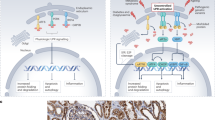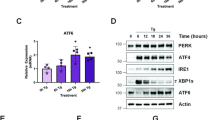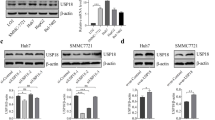Abstract
The unfolded protein response (UPR) is involved in a diverse range of pathologies triggered by endoplasmic reticulum (ER) stress. Endeavor to seek selective regulators of the UPR is a promising challenge towards therapeutic intervention in ER stress-related disorders. In the present report, we describe aberrant, differential and bidirectional regulation of the UPR by 3′-deoxyadenosine (cordycepin) towards cell survival. 3′-Deoxyadenosine blocked ER stress-induced apoptosis via inhibiting the IRE1–JNK pro-apoptotic pathway. 3′-Deoxyadenosine also inhibited apoptosis through reinforcement of the pro-survival eIF2α signaling without affecting PERK activity. It was associated with depression of GADD34 that dephosphorylates eIF2α, and dephosphorylation of eIF2α by salubrinal mimicked the anti-apoptotic effect of 3′-deoxyadenosine. Unexpectedly, although 3′-deoxyadenosine caused activation of eIF2α, it inhibited downstream pro-apoptotic events including induction of ATF4 and expression of CHOP. Cooperation of adenosine transporter and A3 adenosine receptor, but not A1/A2 receptors, mediated the pluripotent effects of 3′-deoxyadenosine. In mice, ER stress caused activation of JNK, expression of CHOP and induction of apoptosis in renal tubules. The apoptosis was significantly attenuated by administration with 3′-deoxyadenosine, and it was correlated with blunted induction of JNK and CHOP in the kidney. These results disclosed atypical pro-survival regulation of the UPR by 3′-deoxyadenosine, which may be advantageous for the treatment of intractable, ER stress-related disorders.
Similar content being viewed by others
Log in or create a free account to read this content
Gain free access to this article, as well as selected content from this journal and more on nature.com
or
Abbreviations
- ER:
-
endoplasmic reticulum
- UPR:
-
unfolded protein response
- ATF6:
-
activating transcription factor 6
- IRE1:
-
inositol-requiring enzyme 1
- PERK:
-
PKR-like ER kinase
- XBP1:
-
X-box-binding protein 1
- ERSE:
-
ER stress response element
- UPRE:
-
UPR element
- GRP78:
-
78 kDa glucose-regulated protein
- ORP150:
-
150 kDa oxygen-regulated protein
- ERAD:
-
ER-associated degradation
- Edem1:
-
ER degradation enhancing α-mannosidase-like protein 1
- eIF2α:
-
eukaryotic translation initiation factor 2α
- CHOP:
-
CCAAT/enhancer-binding protein-homologous protein
- GADD34:
-
growth arrest and DNA damage gene 34
- ASK1:
-
apoptosis signal-regulating kinase 1
- JNK:
-
c-Jun N-terminal kinase
- DTT:
-
dithiothreitol
- SubAB:
-
subtilase cytotoxin
- DPSPX:
-
1,3-dipropyl-8-(p-sulfophenyl)xanthine
- NBTI:
-
S-(4-nitrobenzyl)-6-thioinosine
- SEAP:
-
secreted alkaline phosphatase
- SV40:
-
simian virus 40
- GAPDH:
-
glyceraldehyde-3-phosphate dehydrogenase
- EF-1α:
-
elongation factor-1α
- CMV:
-
cytomegalovirus
- TUNEL:
-
terminal deoxynucleotidyl transferase-mediated dUTP-biotin nick end labeling
- FBS:
-
fetal bovine serum
- DAPI:
-
4′-6-diamidino-2-phenylindole
- XBP1(U):
-
unspliced form of XBP1
- XBP1(S):
-
spliced form of XBP1
References
Aridor M, Balch WE . Integration of endoplasmic reticulum signaling in health and disease. Nat Med 1999; 5: 745–751.
Wu J, Kaufman RJ . From acute ER stress to physiological roles of the unfolded protein response. Cell Death Differ 2006; 13: 374–384.
Boyce M, Bryant KF, Jousse C, Long K, Harding HP, Scheuner D et al. A selective inhibitor of eIF2α dephosphorylation protects cells from ER stress. Science 2005; 307: 935–939.
Wiseman RL, Balch WE . A new pharmacology–drugging stressed folding pathways. Trends Mol Med 2005; 11: 347–350.
Kim R, Emi M, Tanabe K, Murakami S . Role of the unfolded protein response in cell death. Apoptosis 2006; 11: 5–13.
Ma Y, Brewer JW, Diehl JA, Hendershot LM . Two distinct stress signaling pathways converge upon the CHOP promoter during the mammalian unfolded protein response. J Mol Biol 2002; 318: 1351–1365.
Novoa I, Zeng H, Harding HP, Ron D . Feedback inhibition of the unfolded protein response by GADD34-mediated dephosphorylation of eIF2α. J Cell Biol 2001; 153: 1011–1022.
Cunningham KG, Manson W, Spring FS, Hutchinson SA . Cordycepin, a metabolic product isolated from cultures of Cordyceps militaris (Linn). Nature 1950; 166: 949.
Kaczka EA, Trenner NR, Arison B, Walker RW, Folkers K . Identification of cordycepin, a metabolite of Cordyceps militaris, as 3′-deoxyadenosine. Biochem Biophys Res Commun 1964; 14: 456–457.
Nakamura K, Yoshikawa N, Yamaguchi Y, Kagota S, Shinozuka K, Kunitomo M . Antitumor effect of cordycepin (3′-deoxyadenosine) on mouse melanoma and lung carcinoma cells involves adenosine A3 receptor stimulation. Anticancer Res 2006; 26: 43–47.
Chang W, Lim S, Song H, Song BW, Kim HJ, Cha MJ et al. Cordycepin inhibits vascular smooth muscle cell proliferation. Eur J Pharmacol 2008; 597: 64–69.
Lallas GC, Courtis N, Havredaki M . K562 cell sensitization to 5-fluorouracil- or interferon-α-induced apoptosis via cordycepin (3′-deoxyadenosine): fine control of cell apoptosis via poly(A) polymerase upregulation. Int J Biol Markers 2004; 19: 58–66.
Wu WC, Hsiao JR, Lian YY, Lin CY, Huang BM . The apoptotic effect of cordycepin on human OEC-M1 oral cancer cell line. Cancer Chemother Pharmacol 2007; 60: 103–111.
Chen LS, Stellrecht CM, Gandhi V . RNA-directed agent, cordycepin, induces cell death in multiple myeloma cells. Br J Haematol 2008; 140: 682–691.
Shi P, Huang Z, Tan X, Chen G . Proteomic detection of changes in protein expression induced by cordycepin in human hepatocellular carcinoma BEL-7402 cells. Methods Find Exp Clin Pharmacol 2008; 30: 347–353.
Erlinge D . Extracellular ATP: a growth factor for vascular smooth muscle cells. Gen Pharmacol 1998; 31: 1–8.
Kumar V, Sharma A . Adenosine: an endogenous modulator of innate immune system with therapeutic potential. Eur J Pharmacol 2009; 616: 7–15.
Czajkowski R, Barañska J . Cross-talk between the ATP and ADP nucleotide receptor signalling pathways in glioma C6 cells. Acta Biochim Pol 2002; 49: 877–889.
Paton AW, Beddoe T, Thorpe CM, Whisstock JC, Wilce MC, Rossjohn J et al. AB5 subtilase cytotoxin inactivates the endoplasmic reticulum chaperone BiP. Nature 2006; 443: 548–552.
Yoshida H, Matsui T, Hosokawa N, Kaufman RJ, Nagata K, Mori K . A time-dependent phase shift in the mammalian unfolded protein response. Dev Cell 2003; 4: 265–271.
Lee AS . The glucose-regulated proteins: stress induction and clinical applications. Trends Biochem Sci 2001; 26: 504–510.
Novoa I, Zhang Y, Zeng H, Jungreis R, Harding HP, Ron D . Stress-induced gene expression requires programmed recovery from translational repression. EMBO J 2003; 22: 1180–1187.
Harding HP, Novoa I, Zhang Y, Zeng H, Wek R, Schapira M et al. Regulated translation initiation controls stress-induced gene expression in mammalian cells. Mol Cell 2000; 6: 1099–1108.
Armstrong JL, Flockhart R, Veal GJ, Lovat PE, Redfern CP . Regulation of endoplasmic reticulum stress-induced cell death by ATF4 in neuroectodermal tumor cells. J Biol Chem 2010; 285: 6091–6100.
Blais JD, Filipenko V, Bi M, Harding HP, Ron D, Koumenis C et al. Activating transcription factor 4 is translationally regulated by hypoxic stress. Mol Cell Biol 2004; 24: 7469–7482.
Nakagawa T, Zhu H, Morishima N, Li E, Xu J, Yankner BA et al. Caspase-12 mediates endoplasmic-reticulum-specific apoptosis and cytotoxicity by amyloid-β. Nature 2000; 403: 98–103.
Hiramatsu N, Kasai A, Hayakawa K, Yao J, Kitamura M . Real-time detection and continuous monitoring of ER stress in vitro and in vivo by ES-TRAP: evidence for systemic, transient ER stress during endotoxemia. Nucleic Acids Res 2006; 34: e93.
Wong YY, Moon A, Duffin R, Barthet-Barateig A, Meijer HA, Clemens MJ et al. Cordycepin inhibits protein synthesis and cell adhesion through effects on signal transduction. J Biol Chem 2010; 285: 2610–2621.
Penman S, Rosbash M, Penman M . Messenger and heterogeneous nuclear RNA in HeLa cells: differential inhibition by cordycepin. Proc Natl Acad Sci USA 1970; 67: 1878–1885.
Müller WE, Seibert G, Beyer R, Breter HJ, Maidhof A, Zahn RK . Effect of cordycepin on nucleic acid metabolism in L5178Y cells and on nucleic acid-synthesizing enzyme systems. Cancer Res 1977; 37: 3824–3833.
Wong YY, Moon A, Duffin R, Barthet-Barateig A, Meijer HA, Clemens MJ et al. Cordycepin inhibits protein synthesis and cell adhesion through effects on signal transduction. J Biol Chem 2010; 285: 2610–2621.
Rutkowski DT, Kaufman RJ . That which does not kill me makes me stronger: adapting to chronic ER stress. Trends Biochem Sci 2007; 32: 469–476.
Yokouchi M, Hiramatsu N, Hayakawa K, Kasai A, Takano Y, Yao J et al. Atypical, bidirectional regulation of cadmium-induced apoptosis via distinct signaling of unfolded protein response. Cell Death Differ 2007; 14: 1467–1474.
Tagawa Y, Hiramatsu N, Kasai A, Hayakawa K, Okamura M, Yao J et al. Induction of apoptosis by cigarette smoke via ROS-dependent endoplasmic reticulum stress and CCAAT/enhancer-binding protein-homologous protein (CHOP). Free Radic Biol Med 2008; 45: 50–59.
Kitamura M, Taylor S, Unwin R, Burton S, Shimizu F, Fine LG . Gene transfer into the rat renal glomerulus via a mesangial cell vector: site-specific delivery, in situ amplification, and sustained expression of an exogenous gene in vivo. J Clin Invest 1994; 94: 497–505.
Lee AH, Iwakoshi NN, Glimcher LH . XBP-1 regulates a subset of endoplasmic reticulum resident chaperone genes in the unfolded protein response. Mol Cell Biol 2003; 23: 7448–7459.
Fernandez J, Yaman I, Sarnow P, Snider MD, Hatzoglou M . Regulation of internal ribosomal entry site-mediated translation by phosphorylation of the translation initiation factor eIF2α. J Biol Chem 2002; 277: 19198–19205.
Iwawaki T, Akai R . Analysis of the XBP1 splicing mechanism using endoplasmic reticulum stress-indicators. Biochem Biophys Res Commun 2006; 350: 709–715.
Bruhat A, Jousse C, Carraro V, Reimold AM, Ferrara M, Fafournoux P . Amino acids control mammalian gene transcription: activating transcription factor 2 is essential for the amino acid responsiveness of the CHOP promoter. Mol Cell Biol 2000; 19: 7192–7204.
Kitamura M, Suto T, Yokoo T, Shimizu F, Fine LG . Transforming growth factor-β1 is the predominant paracrine inhibitor of macrophage cytokine synthesis produced by glomerular mesangial cells. J Immunol 1996; 156: 2964–2971.
Acknowledgements
We thank Dr. Laurie H. Glimcher (Harvard Medical School), Dr. Ronald C. Wek (Indiana University School of Medicine), Dr. Takahiro Taira (University of Yamanashi), Dr. Takao Iwawaki (RIKEN), Dr. Takeshi Omasa (Osaka University), Dr. Pierre Fafournoux (INRA de Theix), Dr. Amy S Lee (University of South California), Dr. Satoshi Ogawa (Kanazawa University), Dr. Nobuko Hosokawa (Kyoto University), Dr. Jianxin Sun (New Jersey Medical School), Dr. Kazunori Imaizumi (University of Miyazaki) and Dr. David Ron (New York University School of Medicine) for providing us with plasmids. We also appreciate Dr. James Paton (University of Adelaide) for a kind gift of SubAB, and Miss Yukiko Kanayama and Mrs. Mikiko Yoda (University of Yamanashi) for technical assistance. This work was supported by Grant-in-Aids for Scientific Research from the Ministry of Education, Culture, Sports, Science and Technology, Japan (No.20390235) to M Kitamura, and in part by the Global COE Program and Smoking Research Foundation.
Author information
Authors and Affiliations
Corresponding author
Ethics declarations
Competing interests
The authors declare no conflict of interest.
Additional information
Edited by G Kroemer
Supplementary Information accompanies the paper on Cell Death and Differentiation website
Rights and permissions
About this article
Cite this article
Kitamura, M., Kato, H., Saito, Y. et al. Aberrant, differential and bidirectional regulation of the unfolded protein response towards cell survival by 3′-deoxyadenosine. Cell Death Differ 18, 1876–1888 (2011). https://doi.org/10.1038/cdd.2011.63
Received:
Revised:
Accepted:
Published:
Issue date:
DOI: https://doi.org/10.1038/cdd.2011.63
Keywords
This article is cited by
-
A novel nucleoside rescue metabolic pathway may be responsible for therapeutic effect of orally administered cordycepin
Scientific Reports (2019)
-
Blockade of Smad signaling by 3′-deoxyadenosine: a mechanism for its anti-fibrotic potential
Laboratory Investigation (2013)
-
Cordyceps militaris and mycelial fermentation induced apoptosis and autophagy of human glioblastoma cells
Cell Death & Disease (2012)



